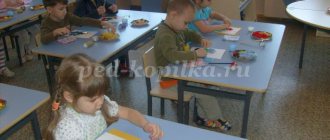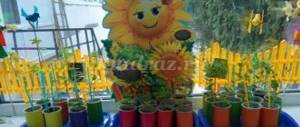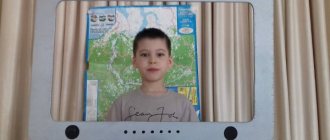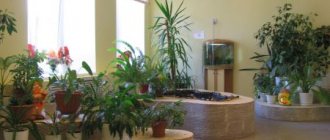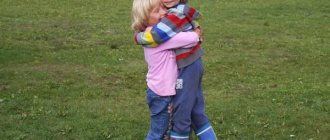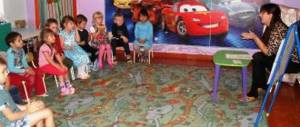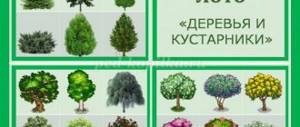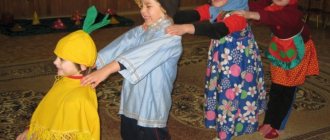Environmental education in kindergarten. Middle group
Report on the topic “Environmental education in kindergarten.”
Author: Nadezhda Gennadievna Kuznetsova, teacher at MBDOU kindergarten No. 2 “Solnyshko”
Introduction. Preschool age is an important stage in the development of human ecological culture.
During this period, the foundations of personality are laid, including a positive attitude towards nature and the surrounding world. At this age, the child begins to distinguish himself from the environment, an emotional and value-based attitude to the environment develops, and the foundations of the moral and ecological positions of the individual are formed, which are manifested in the child’s interactions with nature, in the awareness of inseparability with it. Thanks to this, it is possible for children to develop environmental knowledge, norms and rules for interacting with nature, develop empathy for it, and be active in solving some environmental problems. At the same time, the accumulation of knowledge in preschool children is not an end in itself. They are a necessary condition for developing an emotional, moral and effective attitude towards the world. Kindergarten is the first link in the system of continuous environmental education, so it is no coincidence that teachers are faced with the task of forming the foundations of a culture of rational environmental management among preschoolers. Fostering a caring attitude towards the natural environment in young children begins in the family and continues to develop in the preschool years in kindergarten. In the “Program of Education in Kindergarten”, instilling in preschoolers love and respect for nature is provided for in a special section. Environmental education is carried out in kindergarten through the entire pedagogical process - in everyday life and in the classroom. In implementing the tasks of environmental education, the natural environment in kindergarten is of great importance. These are corners of nature in all groups, a nature room, a winter garden, a properly designed and cultivated area, providing the opportunity for constant direct communication with nature; organizing systematic observations of natural phenomena and objects, introducing children to regular work. Formation of elementary ecological ideas in the middle group of kindergarten.
Children of the fifth year of life should maintain an interest in natural phenomena and develop the ability to interact with the outside world. Children are taught to draw basic conclusions, share their impressions from communicating with nature, and express their attitude towards the natural world in stories and productive activities. Children's acquaintance with nature and environmental education continues in classes, during excursions, observations, experimental activities, outdoor, didactic and role-playing games. In the process of games - dramatizations, children learn to imitate the movements of animals, evaluate the behavior of animals - fairy-tale characters. When organizing children's activities, one should point out the need to follow certain rules in relation to peers and adults. It is important to help children see the dependence of the organization of the entire life of the entire group on the behavior of each child. It is necessary to teach children to listen and hear the speech of others, to use the volume correctly, taking into account the conditions of communication, and to use polite words. The teacher should encourage the child's friendly tone in communicating with people around him. When teaching children to be orderly and cultivating a caring attitude towards things, you should draw their attention to the fact that people’s labor is invested in the creation of each thing. (For example, if a child did not wash his hands well, leaving dirty stains on the towel, this is disrespect for the work of the laundress, etc.). In the process of eating, ventilating a group room, and developing cultural and hygienic skills, children should be explained the appropriateness of procedures and taught to draw basic conclusions on their own. During classes and play activities, explain to children the important role nutrition plays in human health; bring them to the understanding that they need to eat not only what they like, but also what is useful for growth and development.
Walks.
At this age, children continue to learn to name such natural phenomena as snowfall, rainbows, leaf fall, etc., to distinguish and name trees, shrubs and herbaceous plants. Their ideas about the diversity of flora and fauna should be clarified and enriched. It is necessary to consolidate children's knowledge about pets, clarify what benefits they bring to humans; develop a desire to care for animals and take care of them. It is necessary to observe animals with children, teach them to admire their beauty, strength and dexterity; tell us that pets are devoted to their owners; a person should be able to keep animals at home. Continue to teach children to recognize and correctly name animals and their babies. A child of the fifth year of life is able to identify the structure of an animal’s body and name its color (for example, a horse has a head, four legs, a tail; there are ears and eyes on the head; the body is covered with hair; the color is gray). During walks, draw children's attention to the behavior of pets - a dog jumps and wags its tail when meeting its owner, a cat is caressed. It is necessary to create a desire to admire nature and take care of it, exercising children in this daily. Continue to teach children to notice changes in the appearance of trees depending on the time of year; consolidate ideas about seasonal changes in nature. Continue to form in children basic ideas about changes in nature (it’s getting colder, the sky has become gray, the wind is warm, the blue clear sky...). strengthen children’s ability to see the beauty of nature, expand their vocabulary (leaf fall, golden, crimson). Clarify ideas about how animals (hare, fox, bear) winter. Learn to observe the behavior of birds at different times of the year. While walking, look at the tracks of birds in the snow, talk with the guys about how a person can help animals and birds in difficult times. Thus, to form in children a desire to help animals and birds in the winter cold. It is necessary to provide children with the opportunity to be active on walks and excursions, to create beautiful bouquets of autumn leaves, and crafts from natural materials. Offer to collect cones, roots, and plant seeds to make crafts.
Games.
To consolidate knowledge about animals, you can invite children to play the game “Pretend an Animal.” Children form a circle. An adult stands in the center of the circle. An animal is shown by facial expressions and movements. Children must guess this animal and repeat the movements. Then you can invite a willing child to the center of the circle to show their animal. You can offer children a game - dramatization to emphasize the common and different in the behavior of animals. The didactic exercise “Yes and No” helps to expand knowledge about natural phenomena. The teacher asks the children questions: “Are there a lot of leaves on the trees in winter? Does it snow in summer? In the summer, do children go sledding down an ice slide? Do butterflies arrive in winter? Is the river covered with ice in summer? " Children must answer “yes” or “no” quickly. Invite children to play with the wind using pinwheels; bring them to the understanding that the stronger the wind, the faster the turntable moves, but in the room the turntable does not spin because there is no wind. To strengthen the ability to classify vegetables and fruits according to certain criteria, you can play the game “What do they plant in the garden?” The teacher asks: “Children, do you know what they plant in the garden? Let's play this game: I will name different words, and you listen carefully. If I name something that is planted in the garden, you will answer “yes,” if I name something that does not grow in the garden, you will say “no.” The one who makes a mistake loses.” The teacher randomly names vegetables and fruits: apple, carrot, tomato, cucumber... To clarify and deepen knowledge about the seasons, you can organize the game “When does this happen?” To consolidate knowledge about the phenomena of the surrounding reality, organize outdoor games “Summer”, “Sparrows and the Cat”, etc. during a walk.
Conversations. Classes.
In classes and conversations, an adult should help children understand that animals cannot be treated like people - fed with sweets, wrapped in a diaper like small children, etc.;
explain the features of the habitat of animals in nature (animals on the ground, birds in the air, fish in the water, worms in the ground). It is necessary to teach children to compare mammals, birds, fish and insects. The teacher needs to explain to the children that animals give birth to their young alive and feed them with milk; the body, as a rule, is covered with hair, a mouth with teeth and four legs. Birds have a body covered with feathers, two wings and two legs, a beak-shaped mouth, and the young hatch from eggs. Fish have an elongated body, usually flattened on the sides, covered with scales; they move in water using their tail and fins; fry emerge from eggs or are born (in viviparous fish). In insects, the body consists of three parts: head, chest, abdomen; it is covered with chitin (thin skin); has six legs, offspring emerge from the testicles. Children’s ideas about insects (ant, butterfly, beetle, ladybug) should be clarified and taught to identify the features of their appearance and movements (a butterfly and a beetle have wings; a butterfly flies, an ant crawls, a beetle both flies and crawls). Children of this age should recognize a frog and know the main features of its appearance (green skin, large eyes on the head, four legs), movements (not only jumps, but also swims), sounds it makes (croaks); recognize and name representatives of the class of reptiles (lizard and turtle), know some features of their appearance and movement (lizards have an oblong body, a long tail is also short, a turtle crawls slowly). Environmental education is also carried out through reading fiction. Artistic creativity, looking at illustrations. In the process of introducing children to works of folklore, teach them to notice and compare the behavior of animals in fairy tales and the habits of animals in nature, show the relationship of living organisms with their habitat.
Make riddles for children, read poems to children. If the children have seen the guessed animal, ask them to share their impressions and describe its appearance. Offer to recall poems and riddles that emphasize this or that feature of the animal. You can show children how to draw an animal and offer to draw a fairy-tale and a real animal. Continue to introduce children to the animal and plant world while looking at illustrations and paintings. In the process of becoming familiar with nature, it is necessary to teach children to make basic conclusions about the relationships and interdependencies in nature. The specificity of literature makes it possible to form a love of nature based on the content of works of art. The works of such writers as V. Bianki, M. Prishvin, K. I. Chukovsky, S. Ya. Marshak, A. L. Barto, S. Mikhalkov and others are suitable for children. The book for children contains a lot of interesting, beautiful, mysterious, because they really want to learn to read, and until they have learned, listen to their elders read. A corner of nature.
In everyday life, the teacher organizes observations of plants in a corner of nature, involves children in carrying out individual assignments, and organizes children’s duty in a corner of nature. In a corner of nature, children participate in feasible labor to care for plants and fish; They learn to water plants, wipe large leathery leaves, spray them, and trim dry leaves. Together with the teacher, feed the plants with fertilizers. To do this, you need to have equipment in the corner of nature - watering cans for watering indoor plants, sticks for loosening, a spray bottle, etc. In a corner of nature you can place sets of pictures on the topics: “Animals”, “Birds”, “Plants”; didactic games; natural materials (cones, acorns, twigs, pebbles, shells).
Development of labor skills and abilities when becoming familiar with natural phenomena.
Children in their fifth year of life should be instilled with a positive attitude towards work and a desire to work; consolidate the ability to carry out individual and collective assignments, negotiate with the help of the teacher on the distribution of work, take care of the timely completion of a joint task. In the autumn, involve children in cleaning leaves. Continue introducing work equipment: rakes, shovels, etc. In winter, it is necessary to learn how to remove snow from paths; sculpt snowmen, showing independence and creativity (decorate snow buildings with colored ice floes, supplement them with natural materials). Children should be involved in feeding wintering birds; learn to help the teacher; put in order the equipment used in work activities (clean, dry, take to a designated place), treat it with care. At the end of April, you can invite the children to sow pea seeds, and at the beginning of May - to plant onions (children make holes and put the seeds). They should develop a sense of satisfaction from the work done. Children, together with the teacher, can perform simple actions in the city and in the flower garden (sowing seeds, watering). It is necessary to show children how to loosen the soil so as not to damage the root system of plants. In the summer, invite children to weed onions (under the supervision of an adult) and take part in caring for vegetables. It is necessary to encourage children to help each other and teach them to accept help from their friends. Children should be taught to observe their surroundings and understand when to water a plant, feed the birds, or wipe the dust. Develop a desire to care for plants and animals. It should be remembered that children of the fifth year of life are more interested in the process of activity than its result.
Experimentation.
It is necessary to tell children that the entire natural environment can be divided into two parts - living and inanimate nature. Let the children themselves give examples of living and inanimate nature. In the process of conducting elementary experiments, bring children to the understanding that light, air and heat are necessary for plant growth; show how indoor plants can turn towards the light. You can observe a plant that receives more light than it needs (in this case, the plant will become light in color). Bring children to understand that lack of light also has a bad effect on plant growth. Show children the importance of water in human life; clarify their knowledge about the properties of water (odorless, colorless; takes the shape of the vessel in which it is located; water can turn into ice and steam; when melting, snow turns into water). To form the concept that water is a priceless gift of nature that must be carefully preserved. Tell that people are doing special work to cleanse reservoirs and rivers. Remember the proverbs and sayings about water. In winter, in the process of sculpting various snow buildings, continue to introduce children to the properties of snow. Tell that particles of exhaust gases and industrial waste emitted into the atmosphere settle on the snow. As a result, the snow becomes dirty. Show children how melted snow turns into dirty water; bring them to understand: you can’t eat snow - it’s dirty, cold (you can catch a cold). Snow and ice are an inexhaustible source of creative play. Children willingly play with snow as if it were sand. The more varied the use of snow in combination with other materials, the more interesting and meaningful the games, children’s observations of the properties of natural materials, the richer their creativity. You can invite children to pour colored water into various molds and freeze them outside. Explain that frozen pieces of ice can be removed by heating the mold in hot water or by thawing them in a warm room. Invite children to draw with sticks on lightly compacted snow; look at the snowflakes, and then invite the children to draw them. It is necessary to explain to children: in order not to get sick, you need to breathe properly outside. It is best to inhale air through the nose and exhale through the mouth. This contributes to greater saturation of the body with oxygen and warming of the air in the nose (warm air enters the person’s lungs). When looking at the stones, ask them to determine their properties (large - small, smooth - rough, light - dark, warm - cold). Invite the children to find a beautiful stone and make up a fairy tale about it. You can organize various games with stones: “Hit the target”, “Toss and catch”. Continue to expand children's knowledge about the properties of sand and clay; Give them the opportunity to see for themselves the qualities and properties of these materials. By introducing a child to the natural world, an adult consciously develops various aspects of his personality, awakens interest and a desire to learn about the natural environment (sphere of intelligence), arouses in the child sympathy for the “hard” independent life of animals, a desire to help them, shows the uniqueness of life in any, even the most bizarre form, the need to preserve it, treat it with respect and care (sphere of morality). A child can and should be shown various manifestations of beauty in the natural world: flowering plants, shrubs and trees in autumn dress, chiaroscuro contrasts, landscapes at different times of the year and much, much more. At the same time, an adult must remember that in nature absolutely everything that lives in full (unspoiled, not poisoned, unlimited) conditions is beautiful - this is the sphere of aesthetic feelings, the aesthetic perception of a child. So, instilling in children a love for nature and the ability to perceive its beauty is one of the important tasks of a kindergarten.
We recommend watching:
Formation of a caring attitude towards the native land in children of senior preschool age Scenario of an environmental holiday in a kindergarten dedicated to World Water Day Formation of an ecological culture in the personality of a preschool child Environmental education of younger preschool children
Similar articles:
Games and exercises on ecology in the senior preparatory group
Story-based and didactic games about the world around us in kindergarten. Average group
environmental week in dhow material (middle group) on the topic
Ecological week in the middle group of preschool educational institutions
(from 04.09.17 to 08.09.17)
Goal: increasing the efficiency of work on environmental education of preschool children.
Tasks:
— To form in children a consciously positive attitude towards natural phenomena and objects;
- naturally develop scientific ideas about the world around us;
- contribute to the systematization of children’s ideas about the diversity of the surrounding nature;
— to promote understanding of the role of man in nature, his perception as a part of nature;
- develop the ability and desire to reflect impressions of communication with nature in artistic and creative activities;
— improve the professional competence of teachers in the issue of environmental education of children of all age groups;
— to involve families of pupils in the issue of environmental education of preschool children.
During the week, environmental education of preschoolers took place in various forms of educational activities. The events were held not only for children, but also for teachers, with the participation of parents.
Monday – “ Ecological Book Day ”
- "Meet the Red Book!"
- Reading fiction: environmental fairy tales (“The War of Mushrooms and Berries”, etc.), “Animals Dress Up in Winter Coats” by G. Skrebitsky, “Light Drops” by M. Prishvin, “Blue Frogs”, “Forest Houses” by V. Bianki, “What is acid rain” by S.N. Nikolaev.
- Ecological quizzes: “Nature connoisseurs”, “Trees around us”, “Birds in the city”
- Riddles of the old man Lesovich
- Memorizing poems about nature, animals, plants, birds.
- Theatrical performances “Old tales in a new way about ecology.”
- Examination of encyclopedias, books with pictures about nature, illustrations, educational cards.
- Manual labor “Let's give a book a second life - save one tree.”
- Application: design of a homemade book.
Tuesday – “A Day in the Animal World”
- Conversation “Animals of central Russia”, “How animals live in the forest”, “Who are domestic animals?”
- The teacher's story about the importance of animals in human life (animals dress a person, warn of danger, protect, etc.), about the difference between wild and domestic animals.
- Examination of paintings, maps, the globe “Journey Around the World”, pay attention to the colors on the globe - water, land.
- Observations of birds in the kindergarten area.
- Role-playing games: “Pet Shop”, “Veterinary Clinic”
- Outdoor games: “Migration of birds”, “Kite and hen”, “Owl”.
- Creative game to imitate animals “They are grazing in the meadow...”.
- Didactic games: “Bird, fish, beast”, “Who lives where?”.
- Printed board games: Dominoes “Animals”. "Birds", "Pisces".
- Reading fiction, memorizing poems on the topic
- Productive activities (sculpting, drawing, applique)
Drawing: “Our feathered friends”, “Funny birdhouses”, environmental and prohibition signs, “Ecology through the eyes of children”, “Our home is planet Earth”, “Drawing nature”.
Modeling: “Small Bird”, “Wild (Domestic) Animals”.
Application: “What animal would I like to take care of?”
- Making crafts from natural materials “Natural fantasies”.
- Exhibition of children's creative works "Animals, birds, forest and I - together a friendly Earth."
- Photo exhibition “My favorite pet”.
Wednesday – “Day of Nature Explorers”
- A series of thematic activities and travel games on environmental protection: “We protect nature!”, “How can we help nature?”, “Rules of conduct in the forest”, “Train travel “Nature”, “Nature of our region”, “ Clean air and water are the country’s wealth”, “Forest is our wealth”, “Why do forest fires happen?”, “Plants under protection”, “We take care of forest wealth”, “Medicinal plants of the region”, “Through good deeds you can become a young ecologist ”, “Man is part of nature”, “Nature is the house where we live”, “Nature, society, man”, “To protect nature means to protect the homeland.”
- Ecological situations for children: What would happen on Earth without water?, What is needed to keep the air clean?, Why is the forest dying?, What can you do to preserve and enhance nature?, “Why is it necessary to protect and take care of the planet? ", "What is our birch and spruce thinking about?" (on the territory of a preschool educational institution), “Why did an indoor flower die” (for example, begonia), “Why does it snow in winter,” “What will happen if insects disappear?” etc.
· Research activities: Conducting experiments, experiments with earth, water, snow, sand, clay, air, etc.
· Designing a developing subject-spatial environment in groups: selection of albums, photographs, illustrations, fiction, other paraphernalia and information on the topic. Center for Nature and Experimentation, “Vegetable Garden on the Window.”
- Observations at the kindergarten site of inanimate nature phenomena and their impact on natural objects.
Thursday – “Ecological Game Day”
- Didactic exercises: “Who is the spruce friends with” (with crossbill - it feeds on seeds, with a hare - it hides under the branches, with a squirrel, a mouse, etc.).
- Didactic games: “Which branch are the children from?”, “Whose leaf?”, “From which tree is the fruit?”, “Ecological traffic light” (Goal: continue to clarify children’s ideas about environmentally correct behavior), “Which flower did the bee land on?” , “Pantry of the native land”, “Recognize the flower”, “Who lives where, what grows where”.
· Production of attributes for role-playing games.
· Role-playing games: “Building an ecological city”, “Flower store”, “Pet store” , “Veterinary clinic”.
· Verbal game: “Choose a word” (sign, actions) Wind - light, strong, warm, cold, damp... Wind - flies, falls, spins, makes noise.
· Printed board games : “Find a match for a flower”, “Make a flower”, “Where it grows”, “Make a bouquet”, dominoes “Animals”, “Fish”, “Berries and Mushrooms”, “Plants Lotto”.
Friday – “Green Service Day” of Aibolit
· Work in a corner of nature “Beauty salon for indoor plants.”
· Acquaintance with musical works about nature: Listening to “The Seasons”, “Waltz of the Flowers” by P.I. Tchaikovsky and other music.
Eco information for parents: Design of visual propaganda, folders, screens for environmental protection. Booklets “How to raise a child who loves nature”, “Take care of birds”.
